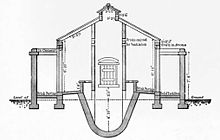Privy midden
Later improvements, such as a midden closet built in Nottingham, used a brick-raised seat above a concave receptacle to direct excreta toward the centre of the pit—which was lined with cement to prevent leakage into the surrounding soil.
The design offered a significant improvement over the less advanced midden-privy, but the problems of emptying and cleaning such pits remained and thus the pail system, with its easily removable container, became more popular.
An investigation of the condition of the city's sewer network revealed that it was "choked up with an accumulation of solid filth, caused by overflow from the middens".
[4] The soil surrounding the old middens was cleared out, connections with drains and sewers removed and dry closets erected over each site.
A contemporary estimate stated that the installation of about 25,000 pail closets removed as much as 3,000,000 imperial gallons (14,000,000 L) of urine and accompanying faeces from the city's drains, sewers and rivers.
